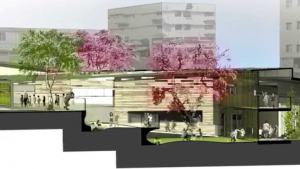 While attending the LearningScapes annual conference this year I was particularly interested in a small break-out session that highlighted junior high school student teams from across the country as they presented their own perception of the “Schools of the Future.” Each of the three diverse teams I sat in on had one common theme; they recognized need to bring nature into the learning environment for hands on and “real-life” experiences that offer the opportunity to engage in learning practically rather than theoretically. Some teams went so far as building parks, rivers and lakes INSIDE their school buildings to learn about ecosystems and interconnectedness. Can you make the entire learning environment an effective ecosystem?
While attending the LearningScapes annual conference this year I was particularly interested in a small break-out session that highlighted junior high school student teams from across the country as they presented their own perception of the “Schools of the Future.” Each of the three diverse teams I sat in on had one common theme; they recognized need to bring nature into the learning environment for hands on and “real-life” experiences that offer the opportunity to engage in learning practically rather than theoretically. Some teams went so far as building parks, rivers and lakes INSIDE their school buildings to learn about ecosystems and interconnectedness. Can you make the entire learning environment an effective ecosystem?
The educational (and health) reasons and benefits for bringing the outdoors inside are numerous and well documented. Here is an article from Private University Products and News that gives you a good summary of the positives. However, there are inherent challenges when trying to design buildings that incorporate nature both inside and out. How, then, as technologists, do we complement and supplement natural and hands on learning while overcoming these obstacles?
- Natural/ Ambient Light vs. displays- Natural light is like the arch-nemesis of most projectors and monitors/ TVs, although flat-panel displays do seem to perform somewhat better in this scenario. Make sure you are prepared with the proper brightness/ lumen output for the environment!
- Dust, Dirt and Debris- Plants me be natural air purifiers, but nature is nature and with it comes small particles that can be sucked into electronics, settle into connections and plugs and create a less-than ideal conditions for equipment. Regular maintenance, outdoor-use certified products and creative enclosures help ensure longer life and proper function. This works for humid conditions too.
- Power– The tech gear, including students’ phones, laptops and tablets still require power. Advanced planning for adequate access and convenient locations is a must!
The opportunities to integrate technology into the environment to enhance educational opportunities are growing. Creating immersive and location specific experiences tied into the students’ environments through QR scanning, interactive displays or augmented reality produces memorable and hands on learning. Enabling and enhancing experiential learning (focus and retention) by combining technology with the natural environment is a unique prospect for educational technologists. This isn’t a future trend; it is what today’s students agree is a necessary part of the 21st century educational environment.
How will you meet these challenges in your school? What unique solutions have you used or will you need to overcome the obstacles?
